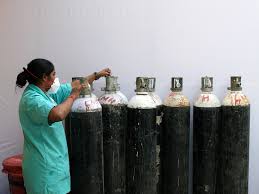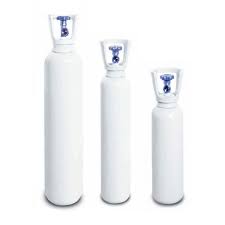OXYGEN CYLINDERS SIMPLIFIED
Oxygen cylinders and oxygen concentrators in Nigeria are used to offer oxygen therapy to patients who are unable to inhale enough oxygen into their bodies on their own. Cylinders and concentrators specifically, are especially designed to supply oxygen to patients at hospitals, home, on the go, or when they are being transferred between medical sites.
The human body cannot sustain without the oxygen that we breathe in through the air. Due to lung diseases, one may not be able to breathe enough oxygen and they might be left short of breath and cause problems with their heart, brain, and other parts of a patient’s body. This is where Oxygen Cylinders step into the picture with Oxygen Therapy.
Let’s take a look at everything that we need to know about Oxygen Cylinders.
What is an oxygen cylinder?
As the effects of Covid-19 came to the fore in Nigeria , researchers and medical professionals observed that coronavirus causes such damage to the lung that impacts its most essential respiratory function, i.e. taking in oxygen and letting out carbon dioxide from the body. The membrane that executes the transfer of oxygen and carbon dioxide is heavily affected, leading to oxygen deficiency, which is then managed by an external oxygen administration system. Oxygen cylinders and concentrators assist the patient’s breathing.
An oxygen cylinder is a storage container which supplies oxygen to a patient through a surgical mask over the nasal cannula. Oxygen cylinders are available in different capacities and they are chosen depending upon the condition of the patient.
How do oxygen cylinders work?
An oxygen cylinder consists of a pressure gauge, flow regulator knob, humidifier bottle, nasal cannula, surgical mask, adapter, and a cylinder. This is how you operate an oxygen cylinder.
- Turn the cylinder’s valve on with the help of a wrench.
- After the valve is open, check the gauge to check the pressure and ensure that there is ample oxygen in the tank.
- Adjust the flow using the flow regulator knob to the rate prescribed by the doctor.
- Attach tubing and nasal prongs as required, and adjust the nasal prongs for a comfortable fit and it is ready to use.

What are the different types of oxygen cylinders?
While there are different types of oxygen cylinders for different purposes like industrial oxygen cylinders, medical oxygen cylinders are made of steel or aluminium. When compared to steel oxygen cylinders, aluminium oxygen cylinders are much lighter in weight. They can be easily transported as they are light.
Oxygen cylinders differ according to the material they are made of and the amount of oxygen filled in litres. Steel oxygen cylinders are available in the following variants: 1 litre, 2 litre, 3 litre, 4 litre, 5 litre, 10 litre, 20 litre, 27 litre, 40 litre, and 50 litre.
Aluminium oxygen cylinders are available in the following variants: 1 litre, 2 litre, 3 litre, 4 litre, 5 litre, and 10 litre.
How are oxygen cylinders different from oxygen concentrators?
Essentially, Oxygen Cylinders and Oxygen Concentrators both provide oxygen to patients who need it, but their methods of delivery are different. In Nigeria oxygen Cylinders are more commonly used, but increasingly Oxygen Concentrators are also becoming popular.
The primary difference is in the way the oxygen is delivered. While Oxygen Cylinders have a finite amount of oxygen compressed within them and that oxygen is inhaled by the user until it runs out, Oxygen Concentrators can generate an infinite supply by filtering and generating medical grade oxygen as the battery that powers this mechanism has life i.e it keeps generating oxygen that never run out as long as it is powered on.
In Cylinders, all the oxygen is already compressed within the tank and that supply is gradually reduced until the tank runs out and needs to be refilled or replaced. An oxygen concentrator functions like an air conditioning machine, where it takes in air, modifies it and delivers it in a new form. This difference also ensures that the dosage (flow rate of the oxygen) methods used by each type of device also differ.
While oxygen cylinders deliver oxygen on Continuous Flow, oxygen concentrators tend to vary by device, as some of the more portable options operate on Pulse-Dose delivery.
How much do oxygen cylinders cost?
Oxygen cylinder prices start from around 15,000 naira , and can go up higher according to their oxygen carrying capacity and other facilities. For the best oxygen cylinder prices, explore the widest collection of oxygen cylinders on mybigpharmacy.com
What to consider while buying an oxygen cylinder?
Choosing an oxygen cylinder can often be difficult. There can be many complexities and technicalities that can be hard to understand while selecting an oxygen cylinder that suits you and your needs. Oxygen cylinders come in a range of sizes from compact and easy to carry ML6 cylinders, to high volume, stationary tanks such as E sized cylinders. Each tank can be used with either the Continuous Flow or Pulse Dose mechanisms.
Continuous Flow (CF) provides a continuous flow of oxygen, whereas Pulse Dose or PD is slightly more advanced. Pulse Dose delivers oxygen in accordance with the user’s breathing pattern. PD can conserve a large amount of oxygen, while Continuous Flow can lead to significant wastage of oxygen because it is being released at a constant rate.
Depending on which kind of oxygen supply system you use, the number of hours of use also varies remarkably. Therefore, with a broad range of weights and sizes on offer, it’s important to choose the size that’s right for you.
Conclusion:
In this blog, we covered some of the basics of oxygen cylinders and several other important things to know about them. Oxygen cylinders are life-saving medical supplies and selecting the right one can make a lot of difference in treatment of patients. At the same time, timely deliveries can make prove to be crucial. For quick delivery and the best oxygen cylinder prices, you can visit the largest catalogue of medical supplies on mybigpharmacy.com Nigeria’s #1 B2B medical and healthtech platform
Have you learnt something new? Go on and share this post with your friends.

